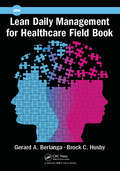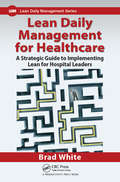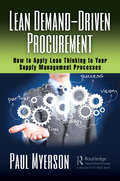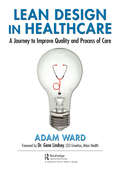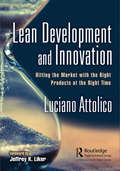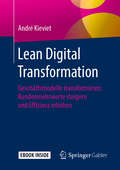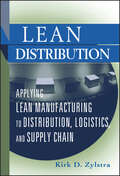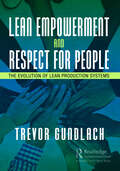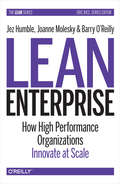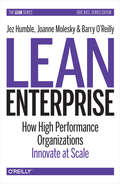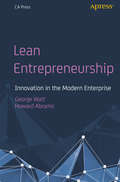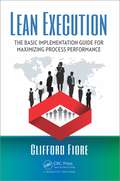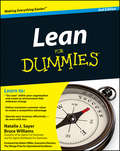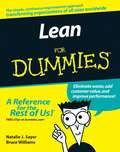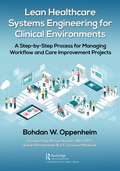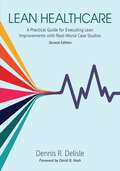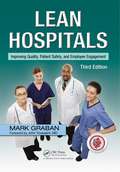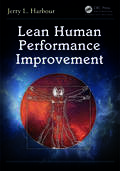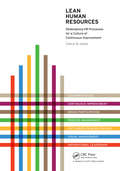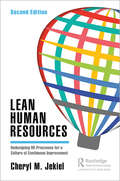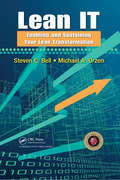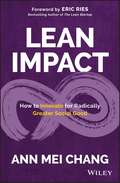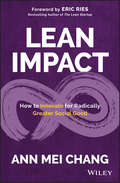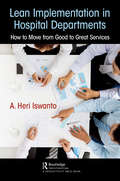- Table View
- List View
Lean Daily Management for Healthcare Field Book
by Gerard A. Berlanga Brock C. HusbyThis book gives healthcare leaders a practical guide to implementing the 4 key components of lean daily management system - 1. LDM boards; 2. Leadership rounds 3. Leader daily disciplines and 4. Lean projects. Although lean is not new to healthcare, effective LDM is just now taking hold with the best lean healthcare organizations in the U.S. and Canada. Leaders are realizing that sustaining their lean projects over time has proven to be a challenge without first addressing the organizations management system/model. LDM gives leaders a straightforward approach to do just that as well as improve their ability to spread and deploy lean to other areas of the organization and tie back to strategy.
Lean Daily Management for Healthcare: A Strategic Guide to Implementing Lean for Hospital Leaders
by Brad WhiteYou likely don’t need any more tools, programs, or workshops to improve your hospital. What you need is a simple and consistent approach to manage problem-solving. Filling this need, this book presents a Lean management system that can help break down barriers between staff, directors, and administration and empower front-line staff to resolve their own problems.Lean Daily Management for Healthcare: A Strategic Guide to Implementing Lean for Hospital Leaders provides practical, step-by-step guidance on how to roll out Lean daily management in a hospital setting. Ideal for leaders that may feel lost in the transition process, the book supplies a roadmap to help you identify where your hospital currently is in its Lean process, where it’s headed, and how your role will change as you evolve into a Lean leader.Illustrating the entire process of implementing Lean daily management, the book breaks down the cultural progression of units into discreet, objectively measurable phases. It identifies what leaders at all levels of the organization must do to progress units into the next phase of development.Complete with case studies from different service areas in the hospital, the book explains how to link problem-solving boards together to achieve meaningful and measurable improvements in: the emergency department, the operating room, discharge times, clinics, quality, and patient satisfaction.After reading this book you will understand how consistent rounding, a few whiteboards, pen-and-paper data, and a focused effort on working the Plan-Do-Study-Act cycle can help you build a common problem-solving bench strength throughout your organization—establishing the framework upon which future improvement can be built.
Lean Demand-Driven Procurement: How to Apply Lean Thinking to Your Supply Management Processes
by Paul MyersonLean thinking has expanded beyond its origins in repetitive manufacturing to other types of manufacturing processes such as process and product processes, and more recently to the administrative, supply chain, and operations management functions in a variety of industries. While there are many books written on the basics of the "supply" side of the supply chain (i.e. strategic sourcing, sourcing/procurement and purchasing), however, there hasn’t been much written on those areas from a Lean perspective. Considering that supply chain costs, primarily procurement and transportation, can range from 50 to 70 percent of sales, it's surprising that this area has not been fully explored. As a result, some companies tend to place too much emphasis on the traditional focus of reducing material costs instead of process improvement. Applying Lean principles to procurement and purchasing processes identifies non-traditional sources of waste, and in some cases, creates a paradigm shift that results in additional benefits to the entire supply chain. This book is unique because it details the basic supply management concepts and processes (i.e. sourcing, procurement, and purchasing) in an easy-to-understand format in combination with with various process improvement tools, methodologies, best practices, examples and cases written from a Lean perspective. It focuses and pinpoints ways to identify waste on the supply side through improved processes and, in some cases, technology.
Lean Design in Healthcare: A Journey to Improve Quality and Process of Care
by Adam WardThis book gives the reader an inside look at creating a new healthcare service using practical examples and scenarios one would face if doing it themselves. This book chronicles the journey of a fictitious healthcare delivery organization using the Simpler Design System principles based on Lean methodologies. While the characters and actual story is fictitious, it is based on the journey many healthcare systems and clients have taken, the issues they have faced, and the successes and failures they’ve had. Tools and approaches used are based on the actual work of Simpler. The story format engages readers and is intended to motivate and inspire executive teams to use the tenets of the book as a guide to launch their own successful implementation of an idea-to-launch methodology. Tools include those gleaned from actual application of Lean Product Development, Agile, Design for Six Sigma, and Design Thinking Principles. Through engaging storytelling and practical theory, this book is written from the perspective of a physician leader that agrees to be the executive sponsor for a service redesign. As the story progresses, the sponsor becomes fascinated with the process and becomes the first VP of Innovation within his organization.
Lean Development and Innovation: Hitting the Market with the Right Products at the Right Time
by Luciano AttolicoUsing Toyota's principles for product and process development, this book focuses the implementation of the Lean system during the past 10 years in dozens of corporations across various industries. The book highlights all steps on the journey from common trouble area to remarkable results. As it is written by a manager for other managers, it contains real work discoveries and insights. The author provides case studies from many different fields of application. The reader gains insight on US and European companies that successfully streamlined their innovation and product-development processes. These companies have overcome difficult periods and major challenges thanks to the ability to innovate with new Lean methodologies and, above all, a new workplace culture and mindset. The goal of this book is to help managers successfully apply Lean principles in the innovation and development area of their company while benefitting from the author's lessons learned during his many years of capitalized experience.This book provides a comprehensive framework that supports, step-by-step, the successful application of Lean principles in the innovation and development areas of the company. Readers learn how to drastically reduce the time required to develop products and discover and eliminate hidden costs and critical waste while increasing value for customers.
Lean Digital Transformation: Geschäftsmodelle transformieren, Kundenmehrwerte steigern und Effizienz erhöhen
by André KievietLernen Sie mit diesem Buch, wie Sie Prozesse der Lean Digital Transformation erfolgreich umsetzenMit seinem Buch „Lean Digital Transformation“ zeigt André Kieviet, dass die Umsetzung digitaler Strukturen innerhalb größerer Organisationen keine unlösbare Aufgabe ist. Finden Sie heraus, wie Sie die Möglichkeiten der Digitalisierung für Unternehmen nutzen können. Ein situatives Ordnungsschema unterstützt Sie bei der Frage nach relevanten, technologischen Werkzeugen.Methodisches Wissen und Praxisempfehlungen stehen im FokusZunächst beantwortet der Autor die grundlegenden Fragen „Was ist Digitalisierung und warum gibt es gerade jetzt diesen Hype?“. Auf diese Weise wird Ihnen dieses Konzept verständlich erläutert. Anschließend widmet sich Kieviet dem pragmatischen Ansatz der Lean Digital Transformation. Der Begriff „Lean“ wurde von ihm bewusst gewählt und beleuchtet zwei Perspektiven:Lean steht für Einfachheit: Firmen sollten nicht digitalisieren, nur um sich einem aktuellen Trend unterzuordnen. Vielmehr geht es um die zielorientierte Nutzung von Informationen mit maschineller Hilfe.Lean steht für das Konzept des Lean Managements: Durch den absoluten Fokus auf den Kundenmehrwert soll jegliche Form der Verschwendung im Rahmen des digitalen Umbruchs reduziert werden.André Kieviet führt diese beiden Dimensionen zusammen. Durch diesen pragmatischen, sowie anhand von Beratungsprojekten entwickelten Ansatz, eignen Sie sich nicht nur neues, methodisches Wissen an. Gleichzeitig dient Ihnen dieses Werk als Praxisleitfaden, mit dem Sie neue Anwendungsfelder der Digitalisierung sowie anwendbare Technologien für Ihr Unternehmen entdecken. Auf diese Weise sind Sie in der Lage, die digitalen Transformationsprozesse von Geschäftsmodellen, Unternehmenskultur oder der Mitarbeiterkommunikation selbst zu meistern – ideal für Praktiker, Unternehmer sowie Berater.
Lean Distribution
by Kirk D. Zylstra"Kirk Zylstra's focus on the customer is a fresh approach to lean. Companies that can bear the burden of variability will develop a strategic advantage in today's volatile market."--Travis Jarrell Institute of Industrial Engineers Program Committee Chair"Lean Distribution is a comprehensive yet concise work with clear leanings. Kirk's experience across a range of industries brings a unique understanding of common opportunities and solutions available to optimize distribution processes. Lean techniques, typically effective in manufacturing processes, are applied in the downstream supply chain in a practical and productive manner that will offer something to any business distributing tangible goods."--F. Jeff Duncan Jr. VP, CIO, and Director of Technology Louisiana Pacific Corp."Lean Distribution has robustly captured the revolution occurring in today's increasingly competitive and global supply chain. Eliminating losses through lean manufacturing and lean distribution initiatives will become even more critical enablers to organizations developing cost-advantaged supply chains."--Rick McDonald Director of Manufacturing The Clorox Company
Lean Empowerment and Respect for People: The Evolution of Lean Production Systems
by Trevor GundlachThere are two pillars of a Lean Management System: Continuous Improvement and Respect for People. Most books about Lean Production have focused overwhelmingly on Continuous Improvement and fail to treat Respect for People as an equal pillar. It is overlooked or understated, resulting not in a Lean house, but in a lean-to structure. It is our responsibility to level out the structure once again.The study of people is messy and exciting. It demands that we explore multiple interdisciplinary studies, including psychology, sociology, philosophy, and even theology. This book runs a parallel course with Lean Production but has a different goal. Instead of production, efficiency, and financial gains, our goal is to understand the reasons why staff come to work in the morning. We can only understand a system when we understand its people. They own the culture.Lean must therefore evolve from a Production System into an Empowerment System.Lean Production will no longer serve the contemporary workforce; knowledge workers, if you are reading this, you are likely a knowledge worker who deserves more than a repackaging of the same ideas. You are not a line worker, and your system should not treat you as such. Therefore, we need a new system. One that prioritizes Respect for People over Continuous Improvement. Leaders in this system must recognize belonging and psychological safety as preconditions to process innovation. New definitions of value and waste—the staples of Lean philosophy—must take on a more human face and propel the change of culture. We must flip Lean on its head for the sake of our modern workforce.
Lean Enterprise
by Joanne Molesky Jez Humble Barry O'ReillyHow well does your organization respond to changing market conditions, customer needs, and emerging technologies when building software-based products? This practical guide presents Lean and Agile principles and patterns to help you move fast at scale--and demonstrates why and how to apply these methodologies throughout your organization, rather than with just one department or team.Through case studies, you'll learn how successful enterprises have rethought everything from governance and financial management to systems architecture and organizational culture in the pursuit of radically improved performance. Adopting Lean will take time and commitment, but it's vital for harnessing the cultural and technical forces that are accelerating the rate of innovation.Discover how Lean focuses on people and teamwork at every level, in contrast to traditional management practicesApproach problem-solving experimentally, by exploring solutions, testing assumptions, and getting feedback from real usersLead and manage large-scale programs in a way that empowers employees, increases the speed and quality of delivery, and lowers costsLearn how to implement ideas from the DevOps and Lean Startup movements even in complex, regulated environments
Lean Enterprise: How High Performance Organizations Innovate At Scale
by Joanne Molesky Jez Humble Barry O'ReillyHow well does your organization respond to changing market conditions, customer needs, and emerging technologies when building software-based products? This practical guide presents Lean and Agile principles and patterns to help you move fast at scaleâ??and demonstrates why and how to apply these paradigms throughout your organization, rather than with just one department or team.Through case studies, youâ??ll learn how successful enterprises have rethought everything from governance and financial management to systems architecture and organizational culture in the pursuit of radically improved performance.Discover how Lean focuses on people and teamwork at every level, in contrast to traditional management practicesApproach problem-solving experimentally by exploring solutions, testing assumptions, and getting feedback from real usersLead and manage large-scale programs in a way that empowers employees, increases the speed and quality of delivery, and lowers costsLearn how to implement ideas from the DevOps and Lean Startup movements even in complex, regulated environments
Lean Entrepreneurship: Innovation In The Modern Enterprise
by George Watt Howard AbramsUtilize this comprehensive guide in your organization to create a corporate incubator that protects innovative ideas from oppressive corporate processes and culture and gives those ideas the resources and environment they need to grow and have the best possible chance to thrive. Innovation is hard. Ironically, innovation in a large enterprise can be even more difficult. Policies designed for mature businesses often crush emerging businesses along with the entrepreneurial spirit of the innovators. Procedures can make it difficult, even impossible, for innovative employees to get their ideas funded, or even seen. As a result, even companies with their roots in innovation can find themselves unable to innovate, with a devastating impact on employee morale and often resulting in the exodus of the most creative employees. In Lean Intrapreneurship the authors leverage decades of personal experience innovating in large enterprises to explore the root causes of failure to innovate in established organizations, and offer a solution to the innovator’s dilemma. The book includes a recipe for creating a repeatable program for innovating in large organizations, including tools, tips, and strategies developed by the authors as they created an innovative incubation program for a multi-billion-dollar technology company. It also offers a wealth of information to help aspiring intrapreneurs and entrepreneurs bring their ideas to life. What You’ll LearnDiscover the most common reasons that innovation fails in established organizationsExplore techniques to make innovative ideas a successFollow a recipe to create a program to enable innovation across your companyUnderstand the power of transparency inside and outside an incubatorDevelop employees and foster a culture of innovation across your company Who This Book Is For Anyone with an innovative idea who wants to make it real but does not know where to begin; anyone struggling to innovate inside an established company; anyone who wishes to make their existing company more lean, agile, and efficient; anyone who wishes to start a program to incubate new, innovative ideas inside an established company
Lean Execution: The Basic Implementation Guide for Maximizing Process Performance
by Clifford FioreMany books explain how to construct a value stream map, but few explain the process conditions and characteristics required to ensure a value stream map can be completed successfully. Lean Execution: The Basic Implementation Guide for Maximizing Process Performance fills this need.Although the book explains Lean methods and tools that maximize proc
Lean For Dummies
by Bruce Williams Natalie J. SayerHave you thought about using Lean in your business or organization, but are not really sure how to implement it? Or perhaps you're already using Lean, but you need to get up to speed. Lean for Dummies will show you how to do more with less and create an enterprise that embraces change.In plain-English writing, this friendly guide explores the general overview of Lean, how flow and the value stream works, and the best ways to apply Lean to your enterprise. You will understand the philosophy of Lean and adopt it not as a routine, but a way of life. This highly informative book teaches you:The foundation and language of LeanHow to map the value stream and using it to your business's advantageThe philosophy of KaizenDifferent tools to improve management, customer service, and flow and pullHow to "Go Lean" within your business and across the industryAvoid common mistakes in implementationSeek out resources for assistanceThis simple, continuous improvement approach that minimizes waste and adds customer value is changing organizations of all sizes all over the world. Lean for Dummies will show you to take charge and engage your enterprise in a Lean transformation!
Lean For Dummies
by Bruce Williams Natalie J. SayerHave you thought about using Lean in your business or organization, but are not really sure how to implement it? Or perhaps you’re already using Lean, but you need to get up to speed. Lean for Dummies will show you how to do more with less and create an enterprise that embraces change. In plain-English writing, this friendly guide explores the general overview of Lean, how flow and the value stream works, and the best ways to apply Lean to your enterprise. You will understand the philosophy of Lean and adopt it not as a routine, but a way of life. This highly informative book teaches you: The foundation and language of Lean How to map the value stream and using it to your business’s advantage The philosophy of Kaizen Different tools to improve management, customer service, and flow and pull How to “Go Lean” within your business and across the industry Avoid common mistakes in implementation Seek out resources for assistance This simple, continuous improvement approach that minimizes waste and adds customer value is changing organizations of all sizes all over the world. Lean for Dummies will show you to take charge and engage your enterprise in a Lean transformation!
Lean Healthcare Systems Engineering for Clinical Environments: A Step-by-Step Process for Managing Workflow and Care Improvement Projects
by Bohdan OppenheimIt has been almost 20 years since the Institute of Medicine released the seminal report titled, Crossing the Quality Chasm. In it, the IoM identified six domains of care quality (safe, timely, effective, efficient, equitable, and patient-centric) and noted a huge gap between the current state and the desired state. Although this report received a great deal of attention, sadly there has been little progress in these areas. In the U.S., healthcare still has huge disparities, is inefficient, and is fragmented with delays in care that are often unsafe. Most U.S. citizens are expected to suffer from a diagnostic error sometime during their lifetime, not receive a large fraction of recommended care, and pay for one of the most expensive systems in the world. Much has been written about quality improvement over the years but many prominent quality and safety experts. Yet progress has been slow. Some have called on the healthcare professions to look outside of healthcare to other industries using examples in nuclear power and airlines for safety, the hotel and entertainment industry for a ‘customer’ focus, and the automotive industry, particularly Toyota for efficiency (Lean). This book by Dr. Oppenheim on lean healthcare systems engineering (LHSE) is a fresh approach that brings forth concepts that systems engineers have used in huge national defense projects. What’s unique in this book is that these powerful system engineering tools are modified to be able to address smaller sized healthcare problems that still involve similar problems in fragmentation and poor communication and coordination. This book is an invaluable reference for a new powerful process named Lean Healthcare Systems Engineering (LHSE) for managing workflow and care improvement projects in all clinical environments. The book applies to ambulatory clinics and hospitals of all types including operating rooms, emergency departments, and ancillary departments, clinical and imaging laboratories, pharmacies, and population health. The book presents a generic rigorous but not mathematical step-by-step process of integrated healthcare, systems engineering and Lean. The book also contains the first major product created with the LHSE process, namely tabularized summaries of representative projects in healthcare delivery applications, called Lean Enablers for Healthcare Projects. Each full-page enabler table lists the challenges and wastes, powerful improvement goals, risks, and expected benefits, and some useful descriptions of the healthcare system of interest. The book provides user-friendly solutions to major problems in healthcare delivery operations in all clinical environments, addressing fragmentation, wastes, wrong incentives, ad-hoc and stove-piped management, lack of optimized processes, hierarchy gradient, lack of systems thinking, “blaming and shaming culture”, burnout of providers and many others.
Lean Healthcare: A Practical Guide for Executing Lean Improvements with Real-World Case Studies
by Dennis R. DelisleLean healthcare is not about being better, but rather to become the best at getting better. Today’s challenge in the healthcare environment is your ability to improve at a greater rate than surrounding competitors. <p><p> This book focuses on the model, strategy, and lessons learned in implementing lean thinking in a practical way. Using real-world case studies, the book provides approaches and tools to facilitate rapid improvements, along with a bonus section on pandemic preparedness. <p><p> By following this accessible, user-friendly guide, you can achieve meaningful results right away.
Lean Higher Education: Increasing the Value and Performance of University Processes, Second Edition
by William K. BalzerIn an environment of diminishing resources, growing enrollment, and increasing expectations of accountability, Lean Higher Education: Increasing the Value and Performance of University Processes, Second Edition provides the understanding and the tools required to return education to the consumers it was designed to serve – the students. It supplies a unifying framework for implementing and sustaining a Lean Higher Education (LHE) transformation at any institution, regardless of size or mission. Using straightforward language, relevant examples, and step-by-step guidelines for introducing Lean interventions, this authoritative resource explains how to involve stakeholders in the delivery of quality every step of the way. The author details a flexible series of steps to help ensure stakeholders understand all critical work processes. He presents a wealth of empirical evidence that highlights successful applications of Lean concepts at major universities and provides proven methods for uncovering and eliminating activities that overburden staff yet contribute little or no added value to stakeholders. Complete with standardized methods for correctly diagnosing workplace problems and implementing appropriate solutions, this valuable reference arms you with the understanding and the tools to effectively balance the needs of all stakeholders. By implementing the Lean practices covered in these pages, your school will be better positioned to provide higher quality education, at reduced costs, with efficient processes that instill pride, maximize value, and respect the long-term interests of your students, faculty, and staff. This second edition contains a substantial update with expanded material and reflects the significant growth of LHE practices in colleges and universities worldwide. Because of advances in best practices, as well as some modest research-based evidence, this second edition includes many enhancements that provide particular value to LHE practitioners and higher education (HE) leaders. Since the initial publication of Lean Higher Education in 2010, the challenges of cost and affordability, competition for students and faculty, and calls for efficiency and accountability have only continued to grow, requiring colleges and universities to pursue more radical and transformative change to ensure their success. This new edition provides a model for change based on more than 50 years of application in business and industry and almost 20 years in HE. It provides the information and evidence demanded by HE leadership to understand and embrace LHE as well as best practices processes and tools for implementing LHE in targeted areas or institution-wide. This book provides a conceptual framework for redesigning any university process, such as admitting students, paying a bill, hiring faculty, or processing a donor gift, in a way that delights the beneficiary of that process, respects the employees who support the process, and reduce the cost of the process.
Lean Hospitals: Improving Quality, Patient Safety, and Employee Engagement, Third Edition
by Mark GrabanOrganizations around the world are using Lean to redesign care and improve processes in a way that achieves and sustains meaningful results for patients, staff, physicians, and health systems. Lean Hospitals, Third Edition explains how to use the Lean methodology and mindsets to improve safety, quality, access, and morale while reducing costs, increasing capacity, and strengthening the long-term bottom line.This updated edition of a Shingo Research Award recipient begins with an overview of Lean methods. It explains how Lean practices can help reduce various frustrations for caregivers, prevent delays and harm for patients, and improve the long-term health of your organization.The second edition of this book presented new material on identifying waste, A3 problem solving, engaging employees in continuous improvement, and strategy deployment. This third edition adds new sections on structured Lean problem solving methods (including Toyota Kata), Lean Design, and other topics. Additional examples, case studies, and explanations are also included throughout the book.Mark Graban is also the co-author, with Joe Swartz, of the book Healthcare Kaizen: Engaging Frontline Staff in Sustainable Continuous Improvements, which is also a Shingo Research Award recipient. Mark and Joe also wrote The Executive’s Guide to Healthcare Kaizen.
Lean Human Performance Improvement
by Jerry L. HarbourAs companies continue their efforts to improve work performance, they must ensure that their ongoing Lean activities include a healthy appreciation for, and recognition of, human performance. Ignoring the human component of work performance can be a recipe for unnecessary waste, inefficiency, and decreased productivity. Lean Human Performance Impro
Lean Human Resources: Redesigning HR Processes for a Culture of Continuous Improvement
by Cheryl M. JekielEncouraging a long overdue shift in thinking, this book gives managers and executives the means to maximize employee potential by first showing them how to increase the improvement power of their HR departments. Cheryl M. Jekiel, who has been implementing Lean initiatives out of HR offices for 20 years, defines the people-related approaches and pra
Lean Human Resources: Redesigning HR Processes for a Culture of Continuous Improvement, Second Edition
by Cheryl M. JekielEncouraging a long overdue shift in thinking, this second edition of this groundbreaking book provides managers and executives with the means to maximize employee potential by first showing them how to increase the improvement power of their HR departments. Cheryl M. Jekiel, who has been implementing Lean initiatives out of HR offices for more than 20 years, defines the people-related approaches and practices needed to alter any cultural dynamic that keeps employees from leveraging their peak abilities. She looks at why so many companies allow this sort of waste to exist, how traditional HR departments have not been especially effective in combating waste, and why current HR departments should be seen differently -- as a partner delivering exceptional customer service to employees. This second edition reflects on the material presented in the first edition, how it has affected Lean HR environments, and how it has changed to accommodate new challenges and practices. It is not only for experts on Continuous Improvement or Lean Implementations, but for readers who are looking to strengthen their HR department and optimize employees’ abilities in the workplace.
Lean IT: Enabling and Sustaining Your Lean Transformation
by Steven C Bell Michael A OrzenWinner of a Shingo Research and Professional Publication AwardInformation Technology is supposed to enable business performance and innovation, improve service levels, manage change, and maintain quality and stability, all while steadily reducing operating costs. Yet when an enterprise begins a Lean transformation, too often the IT department is ei
Lean Impact: How To Innovate For Radically Greater Social Good
by Eric Ries Ann ChangDespite enormous investments of time and money, are we making a dent on the social and environmental challenges of our time? What if we could exponentially increase our impact? Around the world, a new generation is looking beyond greater profits, for meaningful purpose. But, unlike business, few social interventions have achieved significant impact at scale. Inspired by the modern innovation practices, popularized by bestseller The Lean Startup, that have fueled technology breakthroughs touching every aspect of our lives, Lean Impact turns our attention to a new goal - radically greater social good. Social change is far more complicated than building a new app. It requires more listening, more care, and more stakeholders. To make a lasting difference, solutions must be embraced by beneficiaries, address root causes, and include an engine that can accelerate growth to reach the scale of the need. Lean Impact offers bold ideas to reach audacious goals through customer insight, rapid experimentation and iteration, and a relentless pursuit of impact. Ann Mei Chang brings a unique perspective from across sectors, from her years as a tech executive in Silicon Valley to her most recent experience as the Chief Innovation Officer at USAID. She vividly illustrates the book with real stories from interviews with over 200 organizations across the US and around the world. Whether you are a nonprofit, social enterprise, triple bottom line company, foundation, government agency, philanthropist, impact investor, or simply donate your time and money, Lean Impact is an essential guide to maximizing social impact and scale.
Lean Impact: How to Innovate for Radically Greater Social Good
by Ann Mei ChangDespite enormous investments of time and money, are we making a dent on the social and environmental challenges of our time? What if we could exponentially increase our impact? Around the world, a new generation is looking beyond greater profits, for meaningful purpose. But, unlike business, few social interventions have achieved significant impact at scale. Inspired by the modern innovation practices, popularized by bestseller The Lean Startup, that have fueled technology breakthroughs touching every aspect of our lives, Lean Impact turns our attention to a new goal - radically greater social good. Social change is far more complicated than building a new app. It requires more listening, more care, and more stakeholders. To make a lasting difference, solutions must be embraced by beneficiaries, address root causes, and include an engine that can accelerate growth to reach the scale of the need. Lean Impact offers bold ideas to reach audacious goals through customer insight, rapid experimentation and iteration, and a relentless pursuit of impact. Ann Mei Chang brings a unique perspective from across sectors, from her years as a tech executive in Silicon Valley to her most recent experience as the Chief Innovation Officer at USAID. She vividly illustrates the book with real stories from interviews with over 200 organizations across the US and around the world. Whether you are a nonprofit, social enterprise, triple bottom line company, foundation, government agency, philanthropist, impact investor, or simply donate your time and money, Lean Impact is an essential guide to maximizing social impact and scale.
Lean Implementation in Hospital Departments: How to Move from Good to Great Services
by A. Heri IswantoLean healthcare is waste elimination in every service area with the goal of reducing inventory, cycle time of service, and cost, so that high-quality patient care can be provided in a way that is as efficient, as effective, and as responsive as possible while retaining the financial integrity of a hospital. The Lean philosophy in healthcare demands a person’s attitude, in all aspects of care, understand the process which happens, observe it, and gather information in order to identify the root of an inefficiency of the process. In short, Lean and its emphasis on efficiency can be a critical tool in the management of health services in hospitals around the world. This book provides guidance and examples on how Lean principles can be implemented into the infrastructure and every day operations of a hospital from the emergency room to hospital facilities and maintenance. The book also demonstrates how Lean is the cultural commitment of organizations to implement the scientific method in designing, conducting, and improving work sustainably through teamwork, bringing in better value and satisfaction to the patient. It shortens the time between ordering and service delivery by eliminating waste from the service flow value. The author uses numerous examples of Lean thinking in various hospital departments with the overall of goal of taking that department from good to great.
